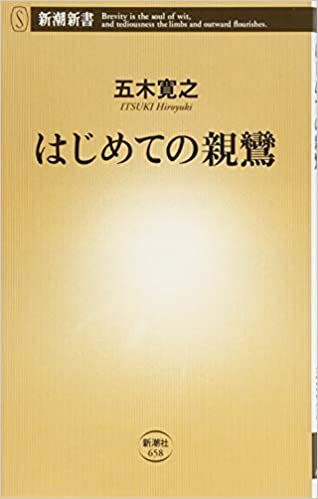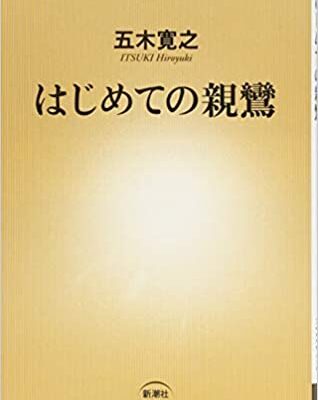五木寛之 著「はじめての親鸞」新潮新書
仏教の基礎的な入門書を読んだ後、空海に興味を持って何冊か読んでみました。高野山や京都の東寺など、空海にゆかりのある場所へは、通訳ガイドの方もお客様を連れていくことがあると思うので、知識を仕入れておくことは仕事に直接役立ちます。
では、次は誰について読んでみようかと考えてみました。平安仏教において、空海と双璧の最澄かとも思いましたが、自分の家の宗派が浄土真宗なので、親鸞について書かれた本を購入しました。
本書は、百寺巡礼を書かれた五木寛之さんの書籍で、新書なので気軽に読めます。親鸞についての詳述は、本書や他の伝記ものを参照いただければと思います。ここでは、私がメモしたいくつかのトピックスのみを記しておきます。
まず、「法螺を吹く」という言葉がありますが、今では「大風呂敷を広げる」意味で、できそうもない大きな話を、さもできるように話すことを意味すると思いますが、本書を引用すると、「法螺を吹くとは、今からお説教が始まるよ、という合図であり、本来、立派なことを言うのが『法螺を吹く』の意味」だったそうです。
次に、呪詛についてです。呪詛と言えば、相手を呪い殺すことで、平安時代の貴族たちが用いたイメージが強いのですが、それだけではなく、納税を滞納する人たちに対しても呪詛の祈りがなされたそうです。当時の庶民大衆は宗教観が強いのか、純朴だったのか、年貢を納めないと呪詛によって死後に地獄へ行くと言われると、恐ろしくて仕方なかったらしいのです。
「法螺を吹く」は日本語の慣用句なので、外国人への説明は難しいと思いますが、呪詛の話は、トピックスとして昔の日本人の考え方を説明するのに使えるのではないでしょうか。(完)

価格:770円
(2021/5/30 15:20時点)
感想(0件)
Hajimete no Shinran” by Hiroyuki Itsuki, Shincho Shinsho
After reading a basic introduction to Buddhism, I became interested in Kukai and read several books on him. I believe that interpreter guides sometimes take their clients to places associated with Kukai, such as Koyasan and Toji Temple in Kyoto, so having the knowledge will directly help them in their work.
Then I thought, who should I read about next? I thought it might be Saicho, the two big figures of Kukai and Saicho in Heian Buddhism, but since my family’s sect is Jodo Shinshu, I bought a book written about Shinran.
This book is by Hiroyuki Itsuki, who wrote 100 Temple Pilgrimage, and is a new book so it can be read easily. For more details about Shinran, please refer to this book and other biographies. Here, I will only note a few topics that I took note of.
First of all, there is the word “hōra-o-fuku,” which nowadays means “to expand the big talk,” and I think it means to talk about big things that are unlikely to be possible, but to quote from this book, “hōrao-fuku is a signal that the sermon is about to begin, and originally, the meaning of hōrao-fuku was to talk about great things.
Next, I would like to talk about curses. The word “curse” is often associated with the image of aristocrats of the Heian period (794-1185) who cursed their opponents to death, but it was also used to pray for people who failed to pay their taxes. It is said that the common people of the time, whether they were religious or naive, were horrified when they were told that if they did not pay their annual tribute, they would be cursed and go to hell after death.
Since “hōrao Fuku” is a Japanese idiom, it would be difficult to explain to a foreigner, but as a topic, the story of the curse could be used to explain the old Japanese way of thinking. (End)
Hajimete no Shinran” par Hiroyuki Itsuki, Shincho Shinsho
Après avoir lu une introduction de base au bouddhisme, je me suis intéressé à Kukai et j’ai lu plusieurs livres sur lui. Je pense que les guides-interprètes emmènent parfois leurs clients dans des lieux associés à Kukai, comme Koyasan et le temple Toji à Kyoto, et que le fait d’avoir ces connaissances les aidera directement dans leur travail.
Puis je me suis demandé sur qui je devrais lire ensuite. Je pensais que ce pourrait être Saicho, les deux grandes figures de Kukai et Saicho dans le bouddhisme Heian, mais comme la secte de ma famille est le Jodo Shinshu, j’ai acheté un livre écrit sur Shinran.
Ce livre est de Hiroyuki Itsuki, qui a écrit 100 Temple Pilgrimage, et c’est un nouveau livre qui peut donc être lu facilement. Pour plus de détails sur Shinran, veuillez vous référer à ce livre et à d’autres biographies. Ici, je ne noterai que quelques sujets que j’ai pris en note.
Tout d’abord, il y a le mot “hōra-o-fuku”, qui signifie aujourd’hui “étendre le grand discours”, et je pense que cela signifie parler de grandes choses qui ont peu de chances d’être possibles, mais pour citer ce livre, “hōrao-fuku est un signal que le sermon est sur le point de commencer, et à l’origine, le sens de hōrao-fuku était de parler de grandes choses.
Ensuite, j’aimerais parler des malédictions. Le mot “malédiction” est souvent associé à l’image des aristocrates de la période Heian (794-1185) qui maudissaient leurs adversaires à mort, mais il était également utilisé pour prier pour les personnes qui ne payaient pas leurs impôts. On raconte que les gens du peuple de l’époque, qu’ils soient religieux ou naïfs, étaient horrifiés lorsqu’on leur disait que s’ils ne payaient pas leur tribut annuel, ils seraient maudits et iraient en enfer après la mort.
Comme “hōrao Fuku” est un idiome japonais, il serait difficile à expliquer à un étranger, mais en tant que sujet, l’histoire de la malédiction pourrait être utilisée pour expliquer l’ancien mode de pensée japonais. (Fin)
